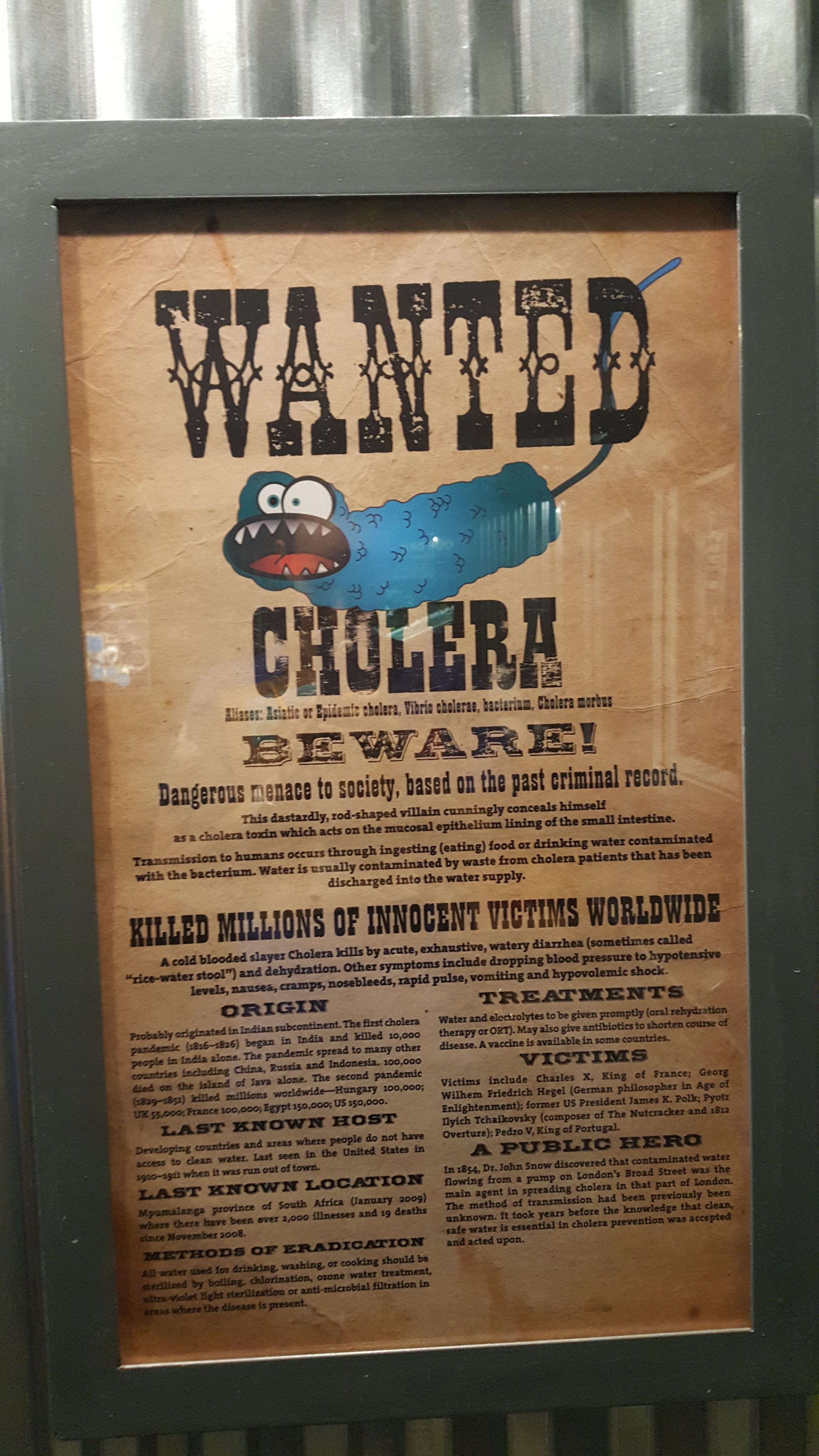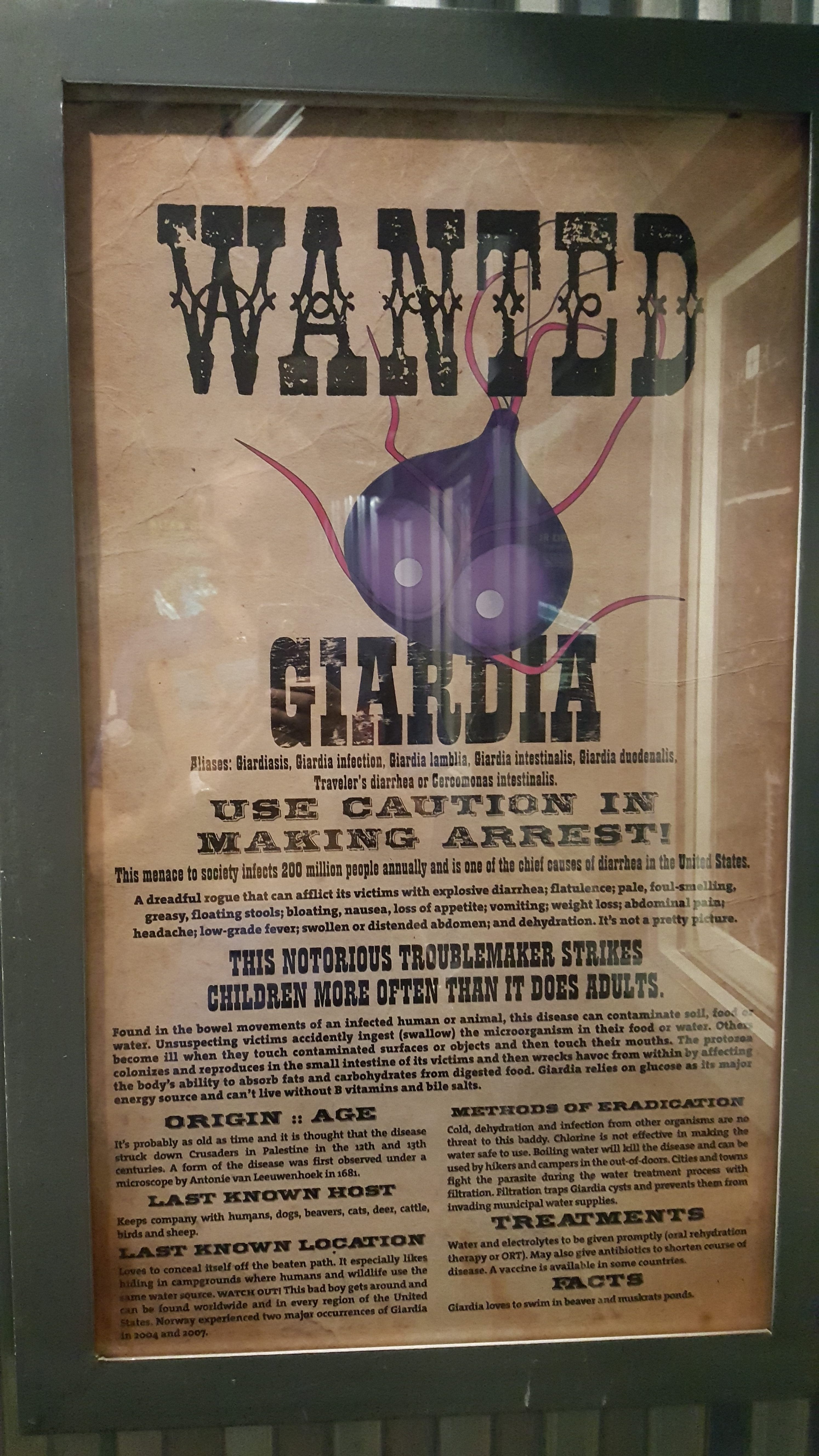The trip to the City of Houston water treatment facility was truly an incredible experience! There were so many things to learn from at the learning center, and I found myself jotting down what felt like hundreds of interesting facts to share with my students later. Our guides were very knowledgeable and they shared with us multiple interesting activities that we could bring back to our classrooms.
One set of items in particular that caught my eye in the learning center was a collection of WANTED posters detailing water-borne pathogens that have wreaked havoc around the world (pictures below). I absolutely loved the creativity of these posters. They were simultaneously engaging, informative, and even made me laugh at some of their creative phrasing. At first, I thought about how much I would love to have these exact posters in my classroom, but after thinking a bit more I came upon an even better idea.
The past two years, I have used project-based learning for our virus and bacteria unit. Previously, I’ve had my students create booklets that could be used to inform patients on the differences between viral & bacterial diseases and their treatments. How fun would it be to somehow incorporate a WANTED poster component? They could be modeled directly after the posters that we saw in the center, providing the same type of information about how they make you sick and their method of transmission and reproduction. As I was thinking about this and looking at the posters, I realized they were a bit out of date. It looks like the last time they were updated was 10 years ago, so many of the “last known location” dates and places are now incorrect. That gave me another idea. How amazing would it be if we could actually team up with the learning center and have students design posters/exhibit components that could actually be implemented in the learning center? I have now made a new commitment to myself to see if there is a way that we could make this happen so that my students can engage in a project that will challenge them to build a final product that will ultimately have an influence that reaches beyond the confines of our classroom.




Krystle and I were also thinking how cool it would be to make the WANTED posters an assignment. I didn’t realize they were out of date so your idea is definitely something awesome. Students will be able to see how science goes beyond their classroom! Let me know how that goes! Do ya’ll teach Viruses in the first semester?
I’ll definitely keep you in the loop! Yes, we do viruses and bacteria as our last unit in fall semester. In the past, my students have loved doing projects to learn the content for that unit. They are very motivated to go above and beyond in finding out information about diseases.
I love your PBL ideas. I did a major PBL unit last year and it’s amazing how much more engaged students are when they know their work is related to the real world. Duh!
Thank you! I am a *huge* believer in PBL. Last year, I designed my biology units to be 100% PBL and overall I love it and the kids do too. Interestingly, the students who give the most pushback are the highest achieving kids who have already learned how to game the memorize-these-facts-I-tell-you system, so it has been an interesting journey trying to retrain their mindsets to see the value in PBL. Have you had any issues with that? What was your PBL unit about?
Hi Laurel, I am amazed by you energy and creativity. Let me know if you think your project on wanted posters could be scaled down to middle school students.
Hi Tom! Thank you for your compliment! I think you could *definitely* use this same idea for middle schoolers. Something that you could do for your middle schoolers that I do for my SPED/ELL students is provide them with a template of the sections that you want on the poster. I can send you an example of one of my templates if you want!
Thanks Laurel, please send, my school email is tpgeiss@episd.org. Look forward to seeing it.
I thought those posters were cool too. That’s great you were so inspired! I like going on the tours and field trips with you. You have a very inquisitive mindset and are always asking the best questions which make for a great teacher!
Aww, Melanie, you are too nice! I love going on field trips with you too! I have learned so many interesting things from you. Thank you for all of your support!
I am so proud of this year’s RET group. You all are taking every experience as a way to enhance your teaching strategies.
I wanted to share a rubric I used years ago for a similar student project. Enjoy!
DISEASE WANTED POSTER
In this investigation, you will gather information on a disease, and then create a “wanted” poster about the disease.
MATERIALS:
Butcher or Legal paper and markers/colored pencils
* any additional supplies are your responsibility.
PROCEDURES:
1. You will be assigned a disease and given time in class to research your disease. Use the questions below as a guide as to what should be included on your poster. The textbook may also be a resource depending on your assigned disease.
2. Using the information that you gather, create a disease “Wanted” poster. Be creative in your design. You may only use written information and/or illustrations.
3. You will be given an opportunity to present your poster to your class. Be prepared to answer questions about your disease from your teacher.
Grading Rubric
Information that must be included
Disease Name — 5 pts
Type of organisms — 5 pts
Scientific name — 5 pts
Pictures — 5 pts
How does the disease work? — 10 pts
Transmission (how it is spread)— 10 pts
Vector — 5 pts
Location of the world affected — 5 pts
Symptoms— 15 pts
Part of the Human/Animal body affected — 5 pts
Treatment— 15 pts
Populations affected — 5 pts
Historical importance of disease — 5 pts
Sources MLA format (L-at least 3; K at least 4) one must be of print media — 5 pts
For students that need more guided direction see below:
DISEASE INFORMATION:
1. Disease Name: (5 pts)
2. What type of organisms causes the disease (for example, bacteria, virus, protist, fungi, worm, etc.)? (5pts)
3. What is the scientific name of the organism that causes the disease? (5pts)
4. Picture or sketch of the organism that causes the disease or what the disease “looks” like. (5 pts)
5. What does the organism do to make someone sick (for example, is it producing toxins, destroying cells, absorbing nutrients, etc.) (10pts)
6. How is the disease spread? (10pts)
7. Is there a vector agent (a vector agent is an organism that spreads the disease, usually an insect)? If so, what is it? (5pts)
8. In what part of the world was the disease first discovered or reported? Or What part of the world is the disease most common? (5pts)
9. What are the symptoms of the disease? (15pts)
10. What body systems or organs are most affected by the disease? (10pts)
11. What is the treatment and/or cure for people with the disease? (15pts)
12. What part of the population does the disease primarily affect (for example, elderly, women, young children, dogs, cats, plants, etc.)? (5pts)
13. What is the disease’s historical importance (for example, did the presence of the disease cause migrations, kill a famous person, become a widespread epidemic, was it associated with major flooding in a region, etc.)? (5pts)
Total points available = 100pts
Thank you, Christina! This is AWESOME! Takes a great leader to have a great group 🙂